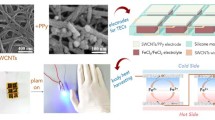Abstract
We examined a working hypothesis of sticky thermoelectric (TE) materials, which is inversely designed to mass-produce flexible TE sheets with lamination or roll-to-roll processes without electric conductive adhesives. Herein, we prepared p-type and n-type sticky TE materials via mixing antimony and bismuth powders with low-volatilizable organic solvents to achieve a low thermal conductivity. Since the sticky TE materials are additionally injected into punched polymer sheets to contact with the upper and bottom electrodes in the fabrication process, the sticky TE modules of ca. 2.4 mm in thickness maintained temperature differences of ca. 10°C and 40°C on a hot plate of 40 °C and 120°C under a natural-air cooling condition with a fin. In the single-cell resistance analysis, we found that 75~150-μm bismuth powder shows lower resistance than the smaller-sized one due to the fewer number of particle-particle interfaces in the electric pass between the upper and bottom electrodes. After adjusting the printed wiring pattern for the upper and bottom electrodes, we achieved 42 mV on a hot plate (120°C) with the 6 × 6 module having 212 Ω in the total resistance. In addition to the possibility of mass production at a reasonable cost, the sticky TE materials provide a low thermal conductivity for flexible TE modules to capture low-temperature waste heat under natural-air cooling conditions with fins for the purpose of energy harvesting.
Similar content being viewed by others
References
L. E. Bell, Science, 321, 1457 (2008).
J.-H. Bahk, H. Fang, K. Yazawa, S. Ali, J. Mater. Chem.C. 3, 10362 (2015).
N. Toshima, Synth Met. 225, 3 (2017).
I. Petsagkourakis, K. Tybrandt, X. Crispin, I. Ohkubo, N. Satoh, T. Mori, Sci. Tech. Adv. Mater. 19, 836 (2018).
T. Mori, S. Priya, MRS Bull. 43, 176 (2018).
K. Nan, S. D. Kang, K. Li, K. J. Yu, F. Zhu, J. Wang, A. C. Dunn, C. Zhou, Z. Xie, M. T. Agne, H. Wang, H. Luan, Y. Zhang, Y. Huang, G. J. Snyder, J. A. Rogers, Science Adv. 4, eaau5849 (2018).
T. Shindo, Y. Nakatani, T. Oishi, Toshiba Rev. 63, 7 (2008).
C. B. Vining, Nat. Mater. 8, 83 (2009).
N. Satoh, M. Otsuka, T. Ohki, A. Ohi, Y. Sakurai, Y. Yamashita, T. Mori Sci. Tech. Adv. Mater. 19, 517 (2018).
S. Iha, S. Akamine, Y. Yamada, Cem. Sci. Concr. Tech. 66, 645 (2012).
Y. Takezawa, Hitachi Chem. Tech. Rep. 53, 5 (2009).
J. Wüsten, K. Potje-Kamloth J. Phys. D: Appl. Phys. 41, 135113 (2008).
T. Kawamori, T. Masaki T. Ogawa, Hitachi Chem. Tech. Rep. 61, 23 (2019).
Author information
Authors and Affiliations
Rights and permissions
About this article
Cite this article
Satoh, N., Otsuka, M., Sakurai, Y. et al. Sticky thermoelectric materials for flexible thermoelectric modules to capture low–temperature waste heat. MRS Advances 5, 481–487 (2020). https://doi.org/10.1557/adv.2020.84
Published:
Issue Date:
DOI: https://doi.org/10.1557/adv.2020.84




